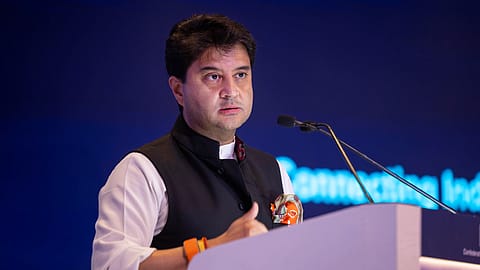India’s digital highway powers a new wave of global entrepreneurship: Jyotiraditya Scindia
Over $10 billion invested in semiconductors; 73,000 women-led startups mark a shift toward inclusive growth.

India is no longer just a domestic market, it’s becoming a global launchpad for products and services, said Communications Minister Jyotiraditya Scindia at the India Mobile Congress 2025, where he added that India’s entrepreneurial and technological transformation over the past decade had turned it from a “services nation” into a product powerhouse.
“India is no longer a domestic market alone,” Scindia said. “Our entrepreneurs, our innovators, our industry have now been able to launch products and services for the globe from India.”
Tracing the country’s journey from mobile revolution to chip manufacturing, Scindia said India has “backward integrated all the way into semiconductor chips” - something that “one could not contemplate a decade ago.”
With over ₹76,000 crore, or $10 billion, already invested under the Semicon India Mission, fabrication plants are being set up from Gujarat on the west coast to Assam in the east. “That’s the capability India has shown,” he said, calling it a sign of how government policy and private enterprise are working in tandem.
Scindia underlined that India’s startup ecosystem, once negligible, now counts over 1.8 lakh startups and unicorns in triple digits. “A country that had only a handful of startups 15 years ago today has greater than 180,000 startups,” he said. Among these, 73,000 are women-led, a trend he described as critical to India’s journey towards Viksit Bharat 2047. “2047 will not be achieved if only 50% of the population are contributing towards that goal,” Scindia said. “This gender equity that we are seeing in the spirit of entrepreneurism is an extremely healthy sign.”
The minister linked this entrepreneurial surge to the scale of India’s digital backbone. “India today houses 1.2 billion mobile subscribers, 974 million internet users, and 944 million broadband connections,” he said. “If you were to classify nations by their digitally connected populations, India would be the third-largest digital nation in the world.”
He also highlighted the country’s dominance in digital payments: 20 billion transactions every month, or 260 billion a year which is worth nearly $3 trillion. “Forty-six percent of the world’s digital transactions happen in India,” Scindia said, calling it a “true sense of empowerment.”
Recommended Stories
“What India has built over the last 11 years,” he said, “is the largest digital highway in the world.” And that, he added, is what gives Indian entrepreneurs the runway to “design in India, solve in India, but scale for the world.”